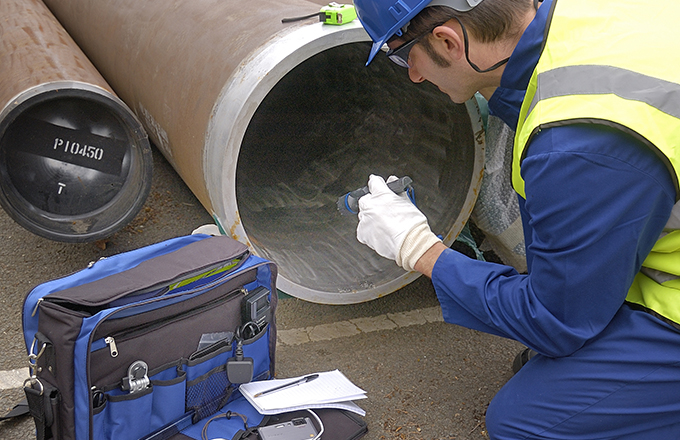Pipeline Welding Inspection: Ensuring Conformity with Industry Requirements
Pipeline Welding Inspection: Ensuring Conformity with Industry Requirements
Blog Article
Advanced Techniques in Pipe Welding Examination: Technologies and Technologies for Enhanced Precision and Integrity in Weld Analysis
The landscape of pipe welding evaluation is going through a substantial change, driven by advanced techniques that assure to improve both precision and integrity in weld evaluations. Developments such as automatic assessment systems and progressed imaging innovations are redefining standard techniques, while non-destructive testing approaches make sure material honesty is kept. As these innovations develop, they not just elevate issue discovery rates however likewise make it possible for much more reliable upkeep methods. However, the effects of these innovations extend beyond immediate advantages, increasing important concerns concerning future techniques and criteria in the sector.

Significance of Weld Assessment
Ensuring the integrity of pipeline welds is critical to the overall safety and dependability of industrial systems. Welds serve as the architectural backbone of pipes, which carry a variety of fluids under varying stress. Flaws in welding can lead to disastrous failures, leading to not just significant financial losses yet additionally potential ecological calamities and risks to public security. Consequently, extensive assessment of welds is essential to the lifecycle of pipeline facilities.
The relevance of weld examination prolongs past plain compliance with governing requirements. It works as a positive procedure to determine and correct imperfections, such as incomplete fusion, porosity, or cracks, before they intensify right into severe concerns. Effective examination strategies also add to the longevity of pipes, reducing maintenance costs and enhancing functional efficiency.
Moreover, extensive weld inspections foster trust fund amongst stakeholders, including regulatory bodies, capitalists, and the communities served by these pipes. By making sure that all welds fulfill the needed criteria, companies can mitigate risks and promote their track records. In recap, weld examination is essential not only for functional integrity yet likewise for the more comprehensive implications it holds for safety and security and ecological stewardship.
Automated Evaluation Equipments
The assimilation of automatic inspection systems in pipe welding has actually changed the technique to ensuring weld high quality and honesty. These systems utilize advanced robotics and expert system to carry out inspections that are not only quicker but likewise more constant than traditional techniques. Automated systems can cover comprehensive lengths of pipes successfully, capturing data that human examiners may overlook because of fatigue or ecological problems.
Among the essential advantages of automatic evaluation systems is their capacity to operate in dangerous settings, decreasing the risk to human inspectors. They make use of different non-destructive testing (NDT) strategies, such as ultrasonic testing and magnetic particle assessment, to analyze weld honesty without compromising the structure. The data accumulated is refined in real-time, enabling prompt responses and punctual rehabilitative activities when issues are recognized.
In addition, automated systems promote the standardization of inspection processes, ensuring that each weld is evaluated versus regular criteria. This not just boosts the reliability of outcomes but also enhances compliance with regulatory standards. As markets continue to focus on security and operational efficiency, the duty of computerized inspection systems in pipeline welding will definitely increase, leading the way for more advanced quality control approaches.
Advanced Imaging Technologies
Often utilized in contemporary pipe welding assessments, advanced imaging modern technologies have actually dramatically boosted the ability to discover and evaluate weld issues. Methods such as electronic radiography, computed tomography, and thermographic imaging provide inspectors with high-resolution photos that expose sub-surface imperfections and structural incongruities that may be invisible to the naked eye.
This leads to faster assessments and boosted accuracy in recognizing vital issues. Calculated tomography, on the other hand, uses three-dimensional imaging, allowing inspectors to picture complicated geometries and examine the integrity of welds from numerous angles.
Thermographic imaging employs infrared technology to find variants in temperature, identifying locations of possible weak point or anxiety within the weld. These advanced imaging innovations not just enhance problem detection rates yet also decrease the time and sources needed for pipeline inspections. Consequently, they play a crucial role in preserving pipeline safety and security and dependability, guaranteeing conformity with industry standards while lessening functional threats.
Non-Destructive Examining Approaches
Making use of different strategies, non-destructive screening (NDT) methods are crucial in pop over here pipe welding evaluations, permitting for the analysis of weld stability without compromising the material's architectural honesty. NDT encompasses a series of techniques, including ultrasonic testing (UT), radiographic testing (RT), magnetic particle testing (MT), and dye penetrant testing (PT) Each technique has distinct advantages and applications depending upon the certain needs of the examination.
Ultrasonic screening utilizes high-frequency acoustic waves to discover inner defects, providing precise measurements of weld density and honesty. Pipeline Welding Inspection. Radiographic testing uses X-rays or gamma rays to informative post create pictures of the weld, exposing interior issues that might not be noticeable on the surface. Magnetic fragment screening is efficient for identifying surface area and near-surface stoppages in ferromagnetic products, while color penetrant testing highlights surface fractures by utilizing a tinted color
Incorporating these NDT techniques right into pipeline welding inspections boosts the accuracy and reliability of weld assessments, guaranteeing that possible failures are recognized early. As industries require greater requirements for safety and efficiency, the function of NDT in keeping the integrity of welded structures remains to be critical in pipe construction and upkeep.

Future Fads in Weld Analysis
As we want to the future of weld evaluation, developments in technology are positioned to change the techniques used for reviewing pipe integrity. The assimilation of expert system (AI) and artificial intelligence in assessment processes is expected to enhance the accuracy of imperfection discovery and predictive upkeep. These technologies permit real-time information analysis, allowing examiners to identify potential problems before they rise into substantial problems.
In addition, using drones equipped with sophisticated imaging systems is acquiring grip. These aerial inspections can cover large areas rapidly, catching high-resolution images and information that can be examined for flaws in hard-to-reach places. This not only boosts security but also increases performance in the examination process.
In addition, the development of clever sensors installed in pipeline systems supplies the possibility for constant surveillance. These sensors can spot changes in pressure, temperature, and vibrations, giving beneficial understandings right into the health and wellness of the welds over time.

Conclusion
To conclude, the combination of sophisticated techniques in pipe welding inspection considerably improves the accuracy and reliability of navigate to this website weld analyses. Advancements such as computerized inspection systems, advanced imaging modern technologies, and non-destructive testing techniques play an essential function in boosting issue detection rates and fostering positive upkeep techniques. As these technologies remain to evolve, they will certainly additionally ensure the safety and performance of pipeline systems, ultimately adding to the integrity of essential infrastructure.

Report this page